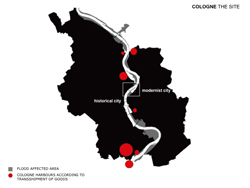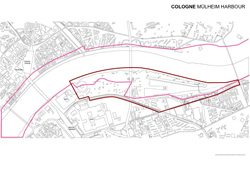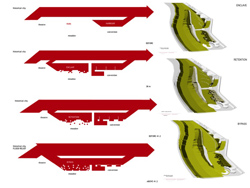| CO/R
CITIES ON RIVERS RESEARCH + DEVELOPMENT |
||||||||
|
This project aims at dismantling the apparent contradiction between the attractiveness of urban water fronts with the concern for flood prevention and safety. The attractiveness of water fronts is confirmed by the eternal desire to live and work in the direct vicinity of the river, which also shows in the achievable land prices along water fronts. Cologne is a city situated on the Rhine. Yet, the channelling of the Upper Rhine and its inherent acceleration of the water flow denies any interaction between city and river. The river allows only a panoramic view of the adjacent water front. Only during periods of flooding are river and city interacting. How can this quality be integrated into urban planning projects without creating the corresponding damage? Areal The chosen site of 160 ha is located on the East bank of the inner city of Cologne, which is characterized by large scale modernist developments: the expo, former industrial production sites, and the Rhine Park. Large parts of the site are located in the 100-year-flood endangered area. Concept The expansion of a derelict harbour basin within the inner city of Cologne by excavating parts of an existing park and meandering the water front of an industrial conversion area, creates a bypass. Due to the different water levels, the landscapes continuous transformation becomes an eminent part of the project. The following water levels were chosen for the project: + 10,00m 45,00m NN state of emergency + 6,20m 41,20m NN termination of shipping traffic + 3,00m 38,00m NN average level Components Tanzbrunnen Open Air Theatre: To redirect the current, the existing open air theatre is remodelled into an amphitheatre. As the water level rises, it is flooded and as the water level exceeds a certain level, it transforms into a water slide, activating the bypass function of the new side arm. This gives flood relief up river on the opposite side, where the historical city of Cologne is situated. During average water levels this feature enables a velocity reduced water exchange. Rhine Park: The site is divided into soft and hard elements- the hard parts which have to withstand the current during flooding are sealed. The soft parts remain a self-generating landscape formed by the existing oak and willow trees, which can be flooded up to 200 days per year. After excavating their vicinity, they remain as a micro-archipelago. The Harbour and the industrial conversion area of the former KHD works: The adjacent industrial conversion zone is reduced to its listed buildings. The gaps between these are excavated to the average water level, creating green pockets, which serve as additional retention capacities during flooding. Due to the lowering of these sites, the length of the water front is increased, which may have a positive effect on land prices as all sites have direct access to the water. To reposition the emergency harbour outside of the current line during flooding, part of the site will be excavated. New swimming piers compensate for the land which has been lost to the river and offer public access as well as moorage for (house) boats. Strategy This project for the East bank attempts to declinate new, less restrictive measures of flood prevention and reduction. New laws prohibit building planning in flood endangered areas. At the same time, as cities are shrinking, the competition for location advantages is continuously gaining momentum, also the conflict between public demand for accessible water (fronts) and the concern for adversity prevention and safety are. These parameters ask for synergetic solutions, which enhance the urban quality of rivers, while incorporating flood preventive measures. As a punctual intervention, this project can be seen as a prototypical strategy to widen the river bed according to the demands of the specific site. Varying water levels create an agile environment also on an urban scale. To incorporate these, instead of neglecting their spatial qualities, not only implies damage prevention, but also a chance to revaluate the specific site. |


